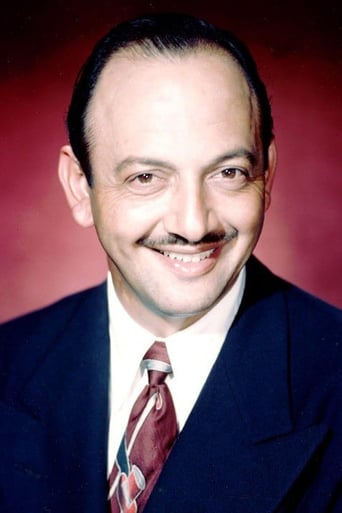Matrixston
Wow! Such a good movie.
Rijndri
Load of rubbish!!
Mathilde the Guild
Although I seem to have had higher expectations than I thought, the movie is super entertaining.
Paynbob
It’s fine. It's literally the definition of a fine movie. You’ve seen it before, you know every beat and outcome before the characters even do. Only question is how much escapism you’re looking for.
MartinHafer
This is a very funny and very unusual Bugs Bunny and Elmer Fudd cartoon. It starts off typically--with Bugs repeatedly tormenting Elmer. Finally, however, Elmer announces he's had enough and he takes out his Warner Brothers contract, tears it up and announces he's done with cartoons! Bugs makes a comment to the audience and then decides that he MUST bring Elmer back into the Warner fold--otherwise he, too, might be out of work. When Bugs finds Elmer, he's sound asleep, so Bugs takes a sleeping pill and enters Elmer's dream in order to torment him (much like a recent Spongebob cartoon). It's all very funny--and filled with a lot of nudity, as Elmer, inexplicably, runs about in fig leaf underwear. Most importantly, however, it is very funny, fast-paced and I love how the cartoon lets you know that the characters know they are cartoons. Really weird and fun.
TheLittleSongbird
I don't think this is the best Bugs and Elmer partnering, A Wild Hare or any entry in the superb Hunting Trilogy I would put over this, but The Big Snooze is still a terrific Looney Tunes cartoon.Animation: Beautiful! A vast majority of the Looney Tunes cartoons have great animation and this is no exception. The backgrounds are pretty, the colours are audacious and the characters are well drawn.Music: I look out for this all the time, and this was not a disappointment either. It was rousing, energetic and whimsical, like the very best scores from the Looney Tunes cartoons are.Story: The weakest asset of the cartoon but still works. It is carefully constructed, with some very effective moments, especially the dream sequence which is by far and away the highlight of the cartoon, but the only criticism of the cartoon is that there are one or two parts at the beginning that seem a little aimless.Dialogue/sight gags: Typical Looney Tunes fashion. The dialogue is inventive and witty and the sight gags are very clever.Characters/ Voices: Nothing to complain about here. Bugs steals the show no doubt about it, but Elmer proves himself a great if rather dumb foil. Mel Blanc and Arthur Q. Bryan's vocal characterisations are consistently superb too.Overall, not the best but still terrific. 9/10 Bethany Cox
phantom_tollbooth
Bob Clampett's final cartoon for Warner Bros. is an appropriately strange and crazy film, a fitting finale for the wackiest director the studio ever saw. 'The Big Snooze' begins unpromisingly with reused animation from an old Tex Avery short and a sequence in which Elmer Fudd quits his role as a cartoon dupe. Although the premise is strong, these early scenes are curiously ugly in both drawings and animation. However, the moment Bugs invades Elmer's dreams and splashes them with Nightmare Paint, 'The Big Snooze' becomes an absolute riot. Since the action is set in the world of dreams, Bugs is able to tear up the rulebook even more than usual. The pace and quality of the wisecracks increase immeasurably and the cartoon goes from ugly to positively sumptuous to look at. The jokes in 'The Big Snooze' are all extremely unconventional, with the closest to a traditional gag being an extreme reading of the old "walk this way" joke. Oddly enough, the cartoon reverts to being bizarrely unattractive the moment the dream sequence ends. Just look at Bugs as the iris closes on him at the end. Nevertheless, 'The Big Snooze' will always be remembered for the dream sequence rather than the clunky sequences that bookend it. While it doesn't quite rival Clampett's very best work, 'The Big Snooze' ends the man's career with Warners on a strikingly inventive note.
bob the moo
After one time too often falling foul of Bugs Bunny's tricks, Elmer Fudd rips up his contract with Warner Brothers Studios and leaves to get some R&R fishing by the lake. Realising that his strongest career sidekick is important in his own career, Bugs goes after him and enters his dreams to encourage him to return to the job at hand.The cartoon starts very abruptly and continues in that vein as scenes appear to just jump around very quickly and without a huge amount of internal structure. The plot cleverly acknowledges a reality of contracts (which of course, isn't reality for cartoon characters) and also has some funny asides from Bugs, but it doesn't appear to have a central plot. The dream sequence is colourful and well drawn but not necessarily funny as a result. I never fully got why Bugs took this approach to the problem!The characters are good. Bugs does his usual stuff but doesn't seem relaxed in the cartoon - the dialogue is edited too fine and close for his style I felt. Fudd has little to do and his character doesn't serve as well as he usually does as a foil to Bugs - he simply isn't given the time to respond in a way he normally is.Overall, almost any cartoon with Bugs and Fudd is going to be work watching for me, but this one just seemed a bit aimless - like the dream sequence was the original idea and the rest of it was just a thin excuse to get to it. It is all over a bit fast and without any really hilarious action, it is OK but really is a poor entry from this famous double act.
